by Sachi Sri Kantha, July 8, 2018
While Sinhalese polemicists like Dr. Dayan Jayatilleka and H.L.D. Mahindapala as well their Indian counterparts Dr. Subramanian Swamy and Narasimhan Ram pollute the Sri Lankan political literature by blaming Prabhakaran and LTTE as the descendants of the Aryan Nazis, Saumiyamoorthy Thondaman Sr. (with his stature as a seasoned politician who cooperated with both Sri Lankan Tamil and Sinhalese politicians for over five decades since 1947) openly identified the ‘Sinhala Only’ slogan of Bandaranaike in 1950s as the proper equivalent of Aryan Nazi culture in Sri Lanka. Sinhala Only predated the rise and popularity of the LTTE in the 1980s, by 30 years. Thus, we will record Thondaman’s thoughts here.
Thondaman on Nazi culture in Ceylon
I provide excerpts from Thondaman Sr.’s autobiography, published in 1994. I presume it was ghost written, but the ghost writer has not been identified. The sentences that appear within parentheses are as in the original.
“ While Vittachi’s book was a clinical post-mortem of the six to eight weeks that followed the outburst of Sinhala fanatics in May 1958, other writers have traced the growth of ethnic violence which stemmed directly for Sinhala Only. A catalogue of the bestial violence perpetrated on Tamils from June 5, 1956 (which was partly abated only after Tamil youth took up arms to fight for a Tamil homeland), is reminiscent of the horrors the Nazis inflicted on Jews and other political opponents.
Not many today seem to know (and those who know do not wish to be reminded) that the concept of a Sinhala Only nation state was a throwback from the Nazi demand for a ‘homeland’ for the so-called ‘Germanic Aryan Race’.”
When Thondaman published his autobiography, few prominent members of Solomon Bandaranaike cabinet, such as Maithripala Senanayake (1916-1998), Wijeyananda Dahanayake (1901-1997), as well as Bandaranaike’s prominent political opponent Junius R. Jayewardene (1906-1996) were alive. Thondaman had also inferred “There is no doubt that the demand for a separate homeland for the Dravidian origin Tamils of Sri Lanka arose from the ‘nationalist’ upsurge which inspired the Sinhalese to want a Sinhala Only nation state.”
On the virulent anti-Tamil pamphlets akin to Nazi hate literature
Tarzie Vittachi’s Emergency ’58 book featured in its back cover an anti-Tamil pamphlet that was distributed by the rabble-rousing Sinhala elements.[ See part 2 of this series – http://sangam.org/60th-anniversary-1958-anti-tamil-riots-part-2/]
Thondaman had also had provided the same details of this anti-Tamil pamphlets as follows:
“In May and June 1958 many pamphlets were sent anonymously by post to the government and selected members of the public warning them of action that would be taken if Tamil protests did not end. I cite a short extract from one of the notices:
‘We are giving you and the Army time till the 28th of this month (May) to clear Tamils out from Panadura to Fort. If by this time this had not been done the whole lot of you will be killed one by one or in groups by hand bombs, shooting or stabbing…Don’t think that you or any of the Tamils will be safe as we have enough petrol to make living torches of all of you and monuments of the Tamil houses. The Muslims and Malays can come later…We have the priests behind us and every temple will come out into the open against you if you try to use force on us. A few of us may die but a lot of you will die faster and in a manner which will make you regret living…We warned death is at your doorstep. Act now and join us in our struggle for freedom from the Tamils and other aliens such as the Muslims, Malays, Burghers etc. all of whom can go to the North and Eastern provinces if they want to remain in Sri Lanka. Our sacred cities of Anuradhapura and Polonnaruwa and our capital cities of Colombo, Kandy and Galle must be made a hundred percent Sinhala without any foreigners or non-Buddhist allowed to live in our midst and to corrupt us…’
It is a pity that neither Tarzie Vittachi nor Thondaman provided any clues towards identifying the culprits who authored and distributed such hate pamphlets. Thondaman did continue further:
“In fact, from May 26th this threat was carried out in full in the worst possible manner, in Colombo, in Panadura, all the coastal towns, in Polonaruwa, Anuradhapura – in fact everywhere where there were Tamils stationed as government officials, or worked as professionals or were engaged in trade…False stories of anti-Sinhalese actions by Tamils were concocted and spread to justify Sinhala hooliganism.”
Thondaman’s thoughts on Sinhalese and indigenous Tamil political leadership
Thondaman did criticize both Sinhalese and Tamil political leaders equally, as follows:
“I was increasingly troubled by the fact that most of the Sinhalese leaders were not inclined to have any negotiations. They felt that the Tamils should accept what was given to them by the majority community without demur. Only Bandaranaike and a few liberals thought otherwise but all that efforts proved futile. To make matters worse, the Tamil leadership was not possessed of the flexibility necessary to negotiate with the Sinhalese who had developed a jingoistic arrogance in the first flush of their new-won ‘freedom’ and political power.
The tactics of the Federal Party and the other Tamils who had enjoyed privileged positions under British colonialism helped to drive all sections of the Sinhalese-speaking persons to come together with one near-homogeneous political entity. It was unfortunate that the Tamils were not able to utilize the religious, caste, territorial and political differences among the Sinhalese to their advantage…”
In addition, Thondaman had portrayed Bandaranaike as a captive of his own short-sighted fickle policies. According to him, “In many ways Bandaranaike was a good man but weak. He could not stand up to the blandishments of Sinhala Only stalwarts. In retrospect, he was perhaps the ‘weakest’ prime minister this country has had since Independence.”
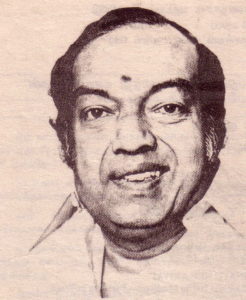
Poet Kannadasan
Poet Kannadasan’s Criticism on Pandit Nehru’s Lackadaisical Attitude
King Poet Kannadsan (1927-1981), then affiliated to the DMK party, penned a highly critical, six stanza verse in Tamil on the lackadaisical attitude taken by Indian prime minister Nehru during the 1958 crisis. For historical record, and to cherish Kannadasan’s word play and ridicule, I provide a scan of the original verse nearby.
A stanza is a unit of group of lines. In this verse, Kannadasan composed eight rhyming lines of each stanza, to a total of 48 rhyming lines. First two stanzas criticized the deeds of the then Indian prime minister Jawaharlal Nehru. Third stanza sympathized with the plight of suffering Eelam Tamils at the hands of hooligans. Fourth and Fifth stanzas ridiculed the hapless situation of the spineless Tamilnadu Congress leadership, then led by K. Kamaraj. Especially, the last two lines of the fifth stanza satirized these politicians as ‘Hang yourself in shame’ in a tamarind tree with a piece of rope. Final stanza invited the Tamilnadu Tamils to rise to the occasion in helping their Eelam kindred. In this stanza also Kannadasan chopped the prides of Tamilnadu Congressmen as barren women (Perumaladi) and impotents (paedi). Though Nehru’s political stock was high in the first post-decade of independent India, young Kannadasan ridiculed him with a satirical nickname ‘Mr. Butter splitter’ (Tiruvaalar Vennai Veddi), as one who soft-pedaled a serious issue for his non-aggressive muted reaction! He chose to address Nehru with his honorific ‘Pundit’ in a ridiculing sense (like what is used in English now for this particular borrowed word), rather than using his name Nehru.
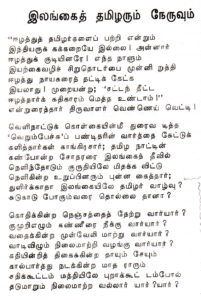
Kannadasan poem on Nehru and Ceylon Tamils page 1
Even when the word ‘Eelam’ was virtually unknown in the Sri Lankan political lexicon in 1950s, Kannadasan used this word twice in the first 8 lines. He even portrayed the prime minister Bandaranaike with the words ‘Eelathu Nayaka’ with a play on his name. Though I attempted to translate this historical verse into English, it’s rather impossible to do justice to Kannadasan’s mastery of Tamil verse. Nevertheless, I provide my translation below for the benefit of those who cannot read Tamil.
‘About the condition of Eelam Tamils
Why Indians should care! – Because
They are citizens of Ceylon! – We cannot
rebuke Eelathu- Nayaka to respect foreign relations.
This cannot be done; To create and implement laws,
They, of course, do have lot of rights!’
So stated, Mister Butter splitter!
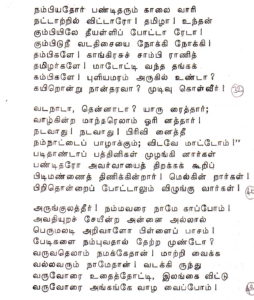
Kannadasan poem on Nehru and Ceylon Tamils page 1
On the foreign policy talk made by this
‘Empty speech’ Pandit, [our]
Congress folks delighted themselves; Tamil Nadu’s
eye-ball like siblings living in Ilankai island
do float in the blood river
these worm-ish members could only smile
Will not the lives of Tamils in Ilankai blossom?
Will it be trouble until one lands in the cemetery?
Who will console the boiling minds?
Who will relieve the flowing tears?
Who will change the hurting thorn-laced borders?
Who will support the wilting lives?
Unshielded surprised mothers and children
Slow stepping humble women folks
Surrounded like pigeons amidst terrorist clique
Who will offer a powerful rescue? – who?
Ain’t the trusted Pundit pull your legs!
Pushed you in mid river – Tamizha!
Ain’t he lit fire in the mire!
You pay repeat obeisance to the North!
Brothers! Congress drooping Tamils
Nose-curbed souls who slave for cow herders!
Is there a tamarind tree nearby? Or
Shall I give a piece of rope? [will] you decide?
‘North Land or South land? Who mention this?
Those who live belongs to One group!
It cannot happen! It cannot happen! Separation Fire
Will hurt our Land: 8we’ll] never allow this!’
This was the noise from the servile clique
Pundit asked these folks to open their mouth
Force fed only sand! [they] simply munch that!
Even any other matter, they’ll gladly gulp!
Blessed folks! We have to protect our folks!
A mother who is blessed with a child
Knows about love for child – a barren woman knows not.
Can we get any relief from [such] impotent?
Whatever happens to us – We only can shape
Our fortune! Lets kick those who
Come here from the North, and welcome
Those who arrive from Ilankai for happy future!
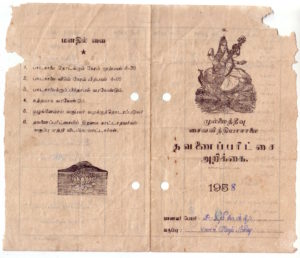
Mullaitivu Saiva Vidyasalai, Sachi’s 1st grade, 1958
My own memorabilia
As I indicated in the part 1 of this series, [http://sangam.org/60th-anniversary-1958-anti-tamil-riots-part-1/], I was living in Mullaitivu in 1958. Thanks to the preservation efforts of my late father Sivapragasam Sachithanantham (1923-2003), I still retain a tattered, termite-eaten four page progress report of my first grade at the Mullaitivu Saiva Vidyasalai. I provide a scan of these four pages too. Pages two and three, in the bottom half indicate the number of students in my class. First term – 22; Second term – 58; Third term – 29.
It is my guess now, that the increase in the number of students during the second term from 22 to 58, reflects the number of students who were temporarily transferred to this school, from the schools that were affected by the riots in the then Vavuniya district. During the 3rd term, the number of students in my class became half of those present during the 2nd term. My inference is that, during the 3rd term, many students who were with us for the 2nd term had returned to their own schools when the situation became tolerable.
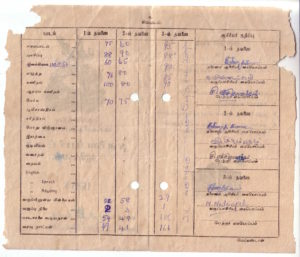
Mullaitivu, Sachi’s 1st grade progress 1st, 2nd, 3rd terms 1958 (2)
My recorded rank in the class during those three terms were 2nd, 3rd and 1st respectively. We were taught only 6 subjects: religion, reading, singing, writing, arithmetic and speech. While the Headmaster of the school (Mr. K. Kanagasabai), as evinced by their signatures on the right half of page 3, had retained his same status in 1958, my class teachers had continued to change for each of the three terms. K. Vijayalakshmi, for 1st term, V. Sithamparam for 2nd term and N. Nadarajah for 3rd term. I wonder whether these four folks, who guided me with the alphabets of learning are still alive or not. If they are living, they should be in their eighties or nineties. Sixty years ago, we never posed for a group photo, as photography was a luxury then. As such, now I don’t have a recollection of the pristine Tamil faces of my four teachers.
For curiosity, I check the current list of schools in the Northern Province of Sri Lanka in the internet, as listed in a Wikipedia entry.
https://wikivisually.com/wiki/List_of_schools_in_Northern_Province,_Sri_Lanka
But, couldn’t locate the name of the school in which I had studied. Thus, I guess with the flow of time, my alma mater has vanished from Mullaitivu.
Cited Sources
Poet Kannadasan: Kannadasan Poems. First two volumes, 10th ed., 1991 (originally published 1968). Vanathi Pathippagam, Chennai, pp. 257-258.
Thondaman: Tea and Politics – An Autobiography, vol. 2- My Life and Times, Navrang – Vijita Yapa, New Delhi, 1994, pp. 149-166.
Thanks Dr. Sachi for the amazing details about the 60th Anniversary of May 1958 Anti-Tamil Riots. I was not aware of the betrayal by Nehru. The betrayal by the Indian leaders continues till today. King Poet Kannadasan’s wish “வடக்கிருந்து வருவோரை உதைத்தோட்டி இலங்கை விட்டு வருவோரை வாழவைப்போம் ” is still a dream. While Eelam Tamils are flourishing in faraway lands, in Tamil Nadu, they suffer in open prisons.
It is sad to know that due to the policies of Lankan Govt, your Alma mater has vanished.